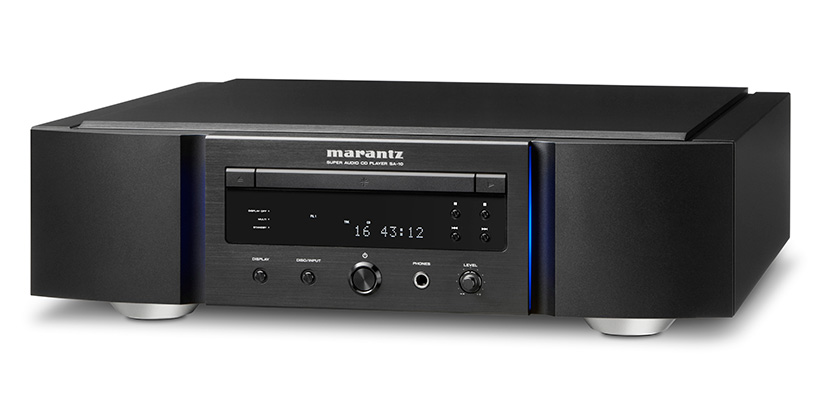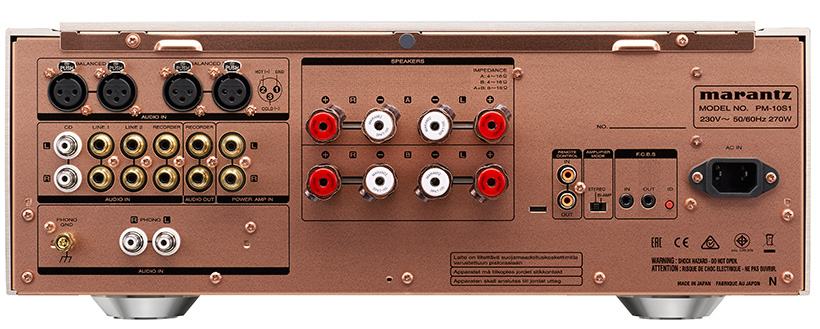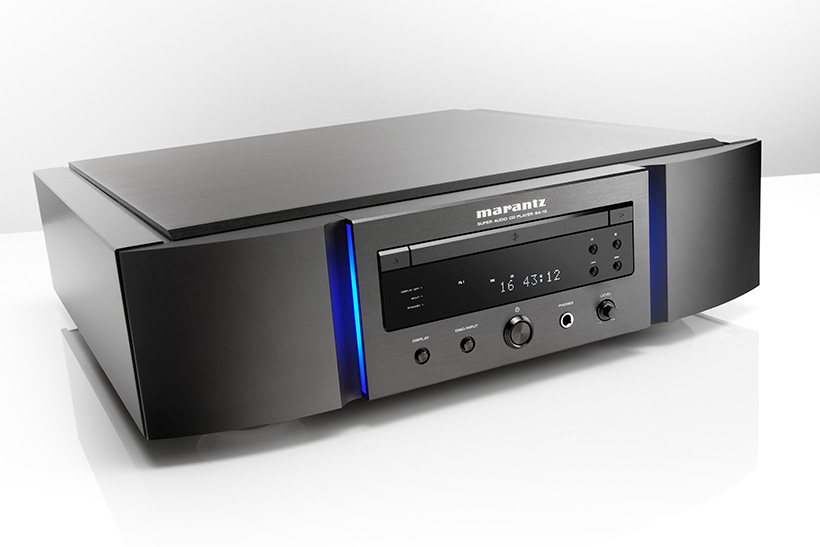Ken Ishiwata is a bona fide hi-fi guru, he’s got the look, the clothes and the underground lair, I mean listening room, to die for. In an unassuming office building in Eindhoven, Holland, Ishiwata has created one of the best sounding rooms in the world (see more here and here). This is where he refines and tunes Marantz electronics not least the range topping models like the new SA-10 SACD/CD player and DAC and its partnering amplifier the PM-10. These two pieces do not look like your typical high end electronics because the design and build is to a standard that can’t achieved with small batch manufacture. In some ways they are perhaps too slick for certain sectors of the market, if you like Boulder, Krell or D’Agostino you might find the 10 series a little too clean cut. If however you realise the benefits of Japanese build quality and the soundsmithing skills of the man in Eindhoven, they will certainly appeal.
Oh, and they weigh as much as anything from Europe or the US. Don’t be fooled by the quality of execution, these are both borderline back breakers. Not least the SA-10 which must be the heaviest digital source component that I’ve had the displeasure of shifting around for ages. But it’s worth the effort for these are exceptionally refined and revealing components, the overall impression they give is of tube liquidity with transistor back-up, proper iron fist/velvet glove stuff. The amplifier in particular makes most of the alternatives sound a bit crude and grainy. The details of these two products were included in my piece last autumn but the following are the key points.

The PM-10 integrated amplifier is the flagship model in the Marantz range, it replaces the SC-7 preamp and MA-9 monoblock combo. A hard act to follow but this is a fully balanced, dual mono design with a bridged output specified to deliver 200 Watts into eight Ohms and double that into four, hence the weight. Marantz calls the power amp section as an “analogue switched mode design”, a radical move for a brand that has not used class D technology before. Ken Ishiwata explains that it’s partly necessary because "today's speakers are all current hungry". But it has also been done because he feels that Marantz has managed to get sound quality out of the design that matches expectations for a Reference product.
The PM-10 is effectively three amplifiers in one box, a preamplifier with its own linear power supply and two bridged mono power amplifiers each with a switched mode supply. Being bridged means that there are two channels of amplification per stereo channel, an arrangement that delivers high power and keeps the return signal (from the speaker) away from ground.

The SA-10 is a disc player and DAC with a difference, in fact several, but it can play FLAC, AIFF and DSD from a DVD-R disc, which separates it from the pack. It also incorporates the Marantz Musical Mastering filtering system that turns PCM signals into DSD style bitstreams using oversampling and a DAC "that's not a DAC" according to Rainer Finck who works with Ishiwata on digital electronics. The other interesting angle is the presence of alternative filter setting options to optimise music and measurement. The default slow roll-off setting is said to sound best but Marantz has included a sharp roll-off option that measures well. The same applies to the noise shaping where the third order shaping set as default doesn’t look as good on paper as the fourth order option but again is more musically convincing in KI’s view.
The SA-10’s DAC uses two clocks to oversample all incoming PCM signals up to 11.2896MHz or 12.288MHz using sample rates up to 256x. This allows the converter proper to work at a one-bit level. But Marantz says that it has replaced the critical element of the converter with technology that is at patent application stage, apparently this is still pending.
So this isn’t just a pretty box, it’s a technically advanced one as well. Connections on the SA-10 include nickel plated RCA phono and balanced outputs, alongside digital inputs for USB, coax and optical connections and outputs for the latter two as well. There’s also a USB A port for iPod/iPhone or a USB thumb drive/memory stick, which probably represents the most purist way to access music albeit without the ease provided by streaming sources. You have to scroll through the contents with the dot matrix display and remote, but it’s a very short and theoretically clean signal path with no need for a wireless network.

The front is pretty sparsely furnished, particularly so if you have the black finish in a dimly lit room. I couldn’t actually find the play button and resorted to the remote handset to get a disc spinning, but it turns out to be on the right hand side of the disc drawer and marked with a machined rather than printed symbol. It seems that reading glasses are no longer optional! There is a button for input changes, a full bore headphone output with level control and a display dimmer plus transport controls. All of the functions are mirrored on the remote handset but as that also operates the amp it takes a bit of getting used to, essentially the source controls are on the top half so it’s pretty straightforward.
The PM-10 amplifier has matching nickel plated input sockets for the CD player, or your prime source of choice, and repeats these for the phono input. The other unusual touch is that the phono and power amp inputs have shorting plugs on them in order to reduce the potential of both to pick up noise in the fashion of an aerial.

There are two pairs of balanced inputs and three more single ended inputs plus a line out and a power amp input for use with an external preamp. The latter might seem strange on such a dedicated integrated design but great preamplifiers are harder to make than power amps, I tried my own line stage and got a very worthwhile upgrade. Two sets of speaker cable binding posts makes bi-wiring straightforward. The front of the amp is very clean, just input select, volume, headphone jack and a power button grace the superbly finished metalwork. As with the SA-10 more functions are available with the remote handset and if you are facing the display it’s easy to read, but less so when its at an angle. The remote allows small volume increments but is a little slow to make big changes.
Sound quality
Listening to the PM-10 with my regular CAD 1543 MkII DAC and Melco N1A server via Bowers & Wilkins 802 D3 speakers reveals it to produce a crisply detailed yet smooth, grainless sound that has tube amp like finesse. It also has drive, that is the music that has this quality loses none of it in the amp’s hands, and the absence of perceived distortion encourages the volume upwards. Which means that a great recording like Bellezza Crudel (Vivaldi, Tone Wik, Barokkanerne, 2L) delivers all the tonal depth of the period instruments alongside the beauty of the soprano voice in the context of an effortless melody. A pretty complete musical experience in fact. This is a fast and powerful amplifier that manages to keep its own character largely under wraps, what there is is a very subtle polish that could be interpreted as lack of grain if it appealed or as a fine veil if not.
It did the kick drum on ‘Too Many Misses’ (Doug MacLeod, Exactly Like This, Reference Recordings) plenty of favours, providing solid yet rounded low end thump that underpins the rhythm in a perfectly timed presentation. The high quality of the recording is made abundantly clear. Faster playing like the hands on the tabla in Bugge Wesseltoft’s ‘Sharangati’ (OK World, Jazzland) is well er, handled, the beats are clearly defined and have a distinct reverb effect that is often blurred by other amps. It’s the combination of speed and finesse that makes many alternatives seem crude, the power reserves are not obvious unless you want to play at higher levels. Many high power amps have a certain solidity to them that imposes itself on the music, and while it’s not unappealing it is a distortion. This Marantz manages keep the not insignificant reserves it has on tap at the service of the music.

The phono input offers two levels of loading and gain adjustment for MCs and one for MM cartridges, and coped with the low ish output of a Rega Apheta 2 with ease, the volume level being very similar to that with a line input. It produces an open, well lit presentation that still has plenty of power and good dynamic range. Which means quieter sounds are well preserved and fine details build a rich and full picture. When the recording is as good as Chasing the Dragon’s España the depth and scale of image is just staggering, the dynamics are pretty good too.
Adding the SA-10 to the mix adds a bit of extra space and air to the proceedings along with a slightly less relaxed balance than the CAD DAC, both running with USB input. But the SA-10 is a pretty sweet converter that delivers music in highly coherent and engaging fashion thanks to precise timing and a clean, low noise presentation that’s highly sensitive to the incoming signal. Contrasting USB with coaxial inputs reveals that the latter is a bit warmer and has a bit more in the way of texture, but that USB is more precise in all respects producing very strong and three dimensional imaging and effortless micro dynamics.

It was interesting to contrast the SA-10’s disc playing with its DAC. The CD player has a strong, bold and even muscular sound that gives way to better tracking of micro dynamics, greater depth of image and a rather more nuanced result when it’s used as a DAC with an external source. This is not far from the result I got last time I compared disc with streamed digits, but that was a while ago and the streaming side of things has moved on quite a bit. At least to the point where the ease of access it offers makes it an approach that’s very hard to resist. But for those with decent CD collections, especially if they contain SACDs there’s a lot to be said for a disc spinner like this.
In Eindhoven Ken Ishiwata was using the Q-Acoustics Concept 500 loudspeakers that I got such a great result with in my room, unfortunately I wasn’t able to repeat that combo but used the aforementioned B&Ws and PMC Fact.8s, and both worked extremely well despite their quite differing characters. Essentially the Marantz pairing needs low colouration, transparent loudspeakers but it doesn’t need high sensitivity. That power rating may not be apparent in the overall character of the PM-10 but it’s there when you want to drive a low sensitivity speaker like the Fact.8 at higher levels. Both source and amp have very, very low perceived distortion which makes itself apparent in a clean, smooth presentation that some might feel lacks the grit of realism. But another view is that it doesn’t add the fine grain that other amplifiers introduce. You only have to hear the intimate yet open sound of Joni Mitchell singing ‘The Man I Love’ (Gershwin’s World, Herbie Hancock, Verve), over a chunky but soft bass line to appreciate just how close the 10 series combo gets to the heart of the music. The sound it produces is as sophisticated as the build and finish of the hardware itself but unlike that it has a soft side that gets you very close to the soul of the music.


